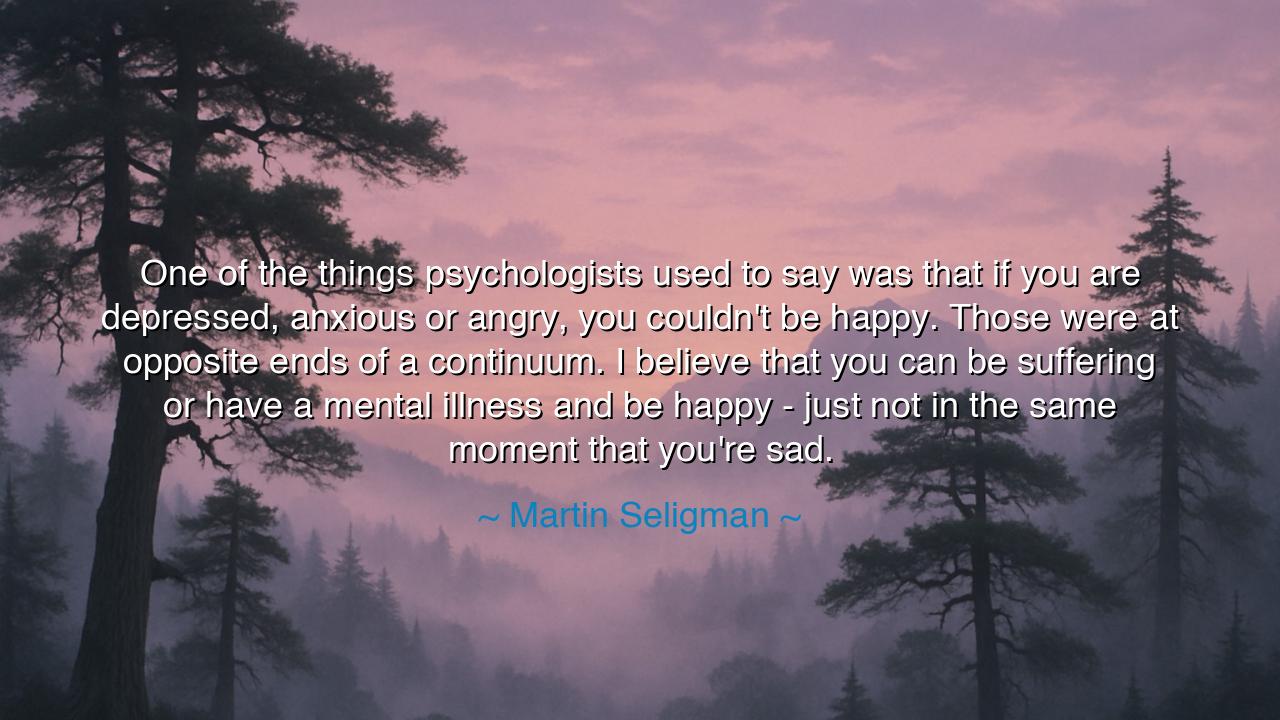
One of the things psychologists used to say was that if you are
One of the things psychologists used to say was that if you are depressed, anxious or angry, you couldn't be happy. Those were at opposite ends of a continuum. I believe that you can be suffering or have a mental illness and be happy - just not in the same moment that you're sad.






Hear the words of Martin Seligman, father of positive psychology, who proclaims: “One of the things psychologists used to say was that if you are depressed, anxious, or angry, you couldn’t be happy. Those were at opposite ends of a continuum. I believe that you can be suffering or have a mental illness and be happy—just not in the same moment that you’re sad.” In this statement, he reshapes the wisdom of the ages: that light and darkness do not destroy one another, but coexist in the same sky, like the sun and the moon sharing their time above the earth.
The heart of this saying is the recognition that human beings are not defined by one emotion at a time. The ancients often spoke of harmony, of the balance of opposites. Happiness is not the absence of sadness; it is the ability to still find meaning, joy, or peace even when sorrow is present elsewhere in the soul. Just as winter does not abolish the memory of summer, so too suffering does not erase the possibility of joy. This is the wisdom Seligman gives us: we are not bound to live only on one end of the spectrum, but may carry both struggle and delight within us.
The ancients themselves hinted at this truth. Aristotle wrote of eudaimonia, not as fleeting pleasure, but as flourishing—living well in accordance with virtue. To flourish did not mean never to weep, but to find meaning even amidst trials. Likewise, the Stoics such as Epictetus declared that even in chains, a man may hold freedom in his spirit, finding peace though the body suffers. These voices echo Seligman’s insight: happiness and suffering are not eternal enemies, but companions who take turns upon the stage of the soul.
Consider also the story of Abraham Lincoln, who battled with deep melancholy throughout his life. Many accounts speak of his despair, of his weary countenance, of the darkness that often clouded his mind. Yet within this same man shone humor, storytelling, compassion, and vision. He led a nation through its darkest hours not because he was free of sadness, but because he held both sorrow and hope within him. His life is living proof of Seligman’s claim: that one may suffer and yet know happiness, though not at the same instant.
The error of the past, Seligman tells us, was the belief that emotions exist only as extremes—that if one is angry, one cannot be at peace, or if one is depressed, one cannot find joy. But life is not a straight line; it is a tapestry. Within one day, a heart may carry grief for what was lost, yet also laughter at a friend’s jest. Within one lifetime, there may be battles with illness, yet also triumphs of love, family, and beauty. To live is not to choose between sorrow and joy forever, but to endure both, knowing each has its place.
The lesson for us is profound: do not believe that your suffering disqualifies you from happiness. Do not think that because you struggle with mental illness, you are forbidden from joy. Happiness does not demand a perfect life; it demands presence in the moments when joy is possible. It may come in small things—a song, a memory, a kindness—even when sadness lies nearby. Accept this, and you will see that joy is not gone; it simply awaits its moment.
Practical wisdom calls us: when sorrow rises, honor it, but do not cling to it as the only truth. Seek also the sparks of happiness that exist alongside it. Cultivate practices of gratitude, connection, and meaning, even in times of hardship. Learn to say: “I am sad now, but joy will come again,” and when joy arrives, let it be embraced fully without guilt. In this way, you will live as the ancients advised—balanced, whole, resilient.
Thus, the words of Martin Seligman shine as a torch: sadness and joy are not eternal enemies, but alternating lights in the same sky. One does not abolish the other. To be human is to walk beneath both sun and moon, knowing that sorrow is real, but so too is happiness. And in this knowledge lies the strength to endure, to flourish, and to pass on hope to generations yet to come.






AAdministratorAdministrator
Welcome, honored guests. Please leave a comment, we will respond soon